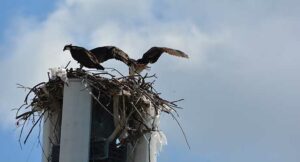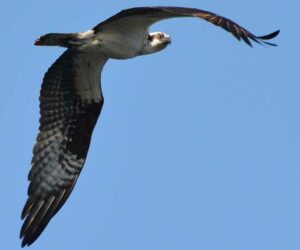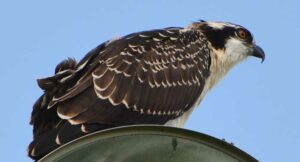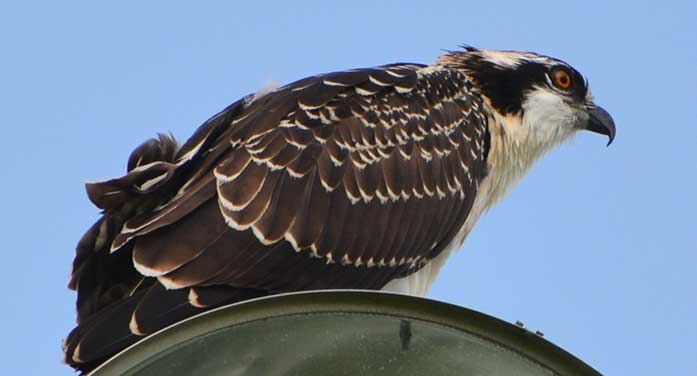 The waterfront of Port Perry, Ont., is hosting new neighbours. Two osprey have taken up residence right in the middle of town on the waterfront.
The waterfront of Port Perry, Ont., is hosting new neighbours. Two osprey have taken up residence right in the middle of town on the waterfront.
These magnificent birds inspire awe but often nest in odd places, such as the light standards and hydroelectric towers. A pair has nested for years at the ball fields at the north of town and others have and are nesting throughout our area.
But one right in town? Wow!
Such nests are familiar sights in many waterfront communities. They are large and bulky, made mostly of sticks, and are always built high on a pole, tall tree or other platform.
 Osprey nesting |
 Osprey in flight |
 Osprey at rest |
One of the wonderful success stories of our times followed the release of Rachel Carson’s exposé Silent Spring in 1962. The book dealt with how vulnerable nature is to human intervention, including the devastating impacts of DDT on birds of prey.
Because of Carson’s research, we can still see eagles, hawks and other birds of prey, including the osprey.
Incorrectly dubbed a “sea eagle” by some, the osprey is actually in a family of its own and can be found worldwide (except for Antarctica). Throughout this vast range, there’s only one species of osprey, which is odd as species generally become genetically divergent by being remote from their peers, and eventually new species emerge.
The osprey is the only hawk in North America that hunts fish almost exclusively and actually dives into the water to get them. Occasionally, they take rodents, rabbits, hares, amphibians, other birds or small reptiles to supplement their diet.
The osprey is a big bird but is surprisingly lightweight, weighing in at between one and two kg. They’re mostly white underneath and fly with a kink in their wings, so they look different from other soaring raptors. Their narrow wings make them agile flyers, and their long legs help them reach deep into the water to catch their prey. Their crested head and large yellow (adult) or orange (immature) eyes are startling to look at and awe-inspiring.
The osprey can live to be 25 years old but generally only survives seven or eight years in the wild, as great-horned owls and golden and bald eagles prey on them.
As they hunt, they soar slowly on their metre-long wings over shallow bodies of water, hover briefly when they spot a fish, then dive feet-first at their prey. Once caught, the fish are repositioned so they face forward to reduce drag as the osprey flies to a perch or its nest.
| RELATED CONTENT |
| Your pet may not be safe in the great outdoors By Geoff Carpentier |
| Birdwatching in Honduras – plumage aplenty By Geoff Carpentier |
| Is the majestic bald eagle making a comeback? By Geoff Carpentier |
Owls and ospreys are the only raptors with an outer toe that can be turned backward, allowing them to grasp their prey with two toes in front and two behind. Sometimes very large fish can be caught and the osprey can’t lift off and must swim to shore.
To assist with their aquatic lifestyle, they have sharp spikes on the underside of the toes, nostrils that can be sealed when diving, backwards-facing scales on their talons to help hold fish, and an oily plumage to prevent feathers from getting waterlogged.
Generally, they mate for life, first breeding when three or four years old. The female lays two to four eggs and incubates them for 35 to 43 days. You can often hear the adult’s sharp whistle near the nest, quite unlike what one would expect from a large bird of prey. Eight to 10 weeks after hatching, the young are out flying on their own, but stick close to their parents for some time.
This is a great time to watch them and, if you’re lucky enough to be near a nest as we are, watch the antics of the young as they learn to hunt and fly. Spring isn’t so silent anymore – at least in the osprey’s world.
To help birds like the osprey, please consider sponsoring me in this year’s Great Canadian Birdathon. You can help me make a difference. To make an online donation, go to my personalized Birdathon link https://www.canadahelps.org/me/6Ktyncn or contact me by email at [email protected].
Geoff Carpentier is a published author, expedition guide and environmental consultant. Visit Geoff on LinkedIn, Instagram and Facebook. For interview requests, click here.
The opinions expressed by our columnists and contributors are theirs alone and do not inherently or expressly reflect the views of our publication.
© Troy Media
Troy Media is an editorial content provider to media outlets and its own hosted community news outlets across Canada.

